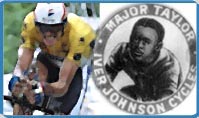|
Anaerobic vs Aerobic
It's one thing to have the brain send a message to the
muscles, but what fuels the muscles during the thousands of contractions
that occur during extended cycling? You've probably heard the terms
aerobic
and
anaerobic.
These terms describe two ways in which your muscles
get energy.
In aerobic exercise, muscles draw on oxygen as well as the glucose and fatty
acids carried in by the blood to produce
adenosine triphosphate
or
ATP. ATP is the energy source that enables muscles
to contract. The ability to keep exercising aerobically depends on the delivery
of oxygen and fuel molecules (glucose and fatty acids) to your muscles.
And that depends on circulation and respiration, provided by your heart
and your lungs.
When exercising anaerobically, muscles are drawing on stores
of glycogen (which is formed from glucose) and converting them to ATP. During
this type of high-intensity exercise the muscles are producing energy without
oxygen--the cardiovascular system is unable to keep up the demand. There
is a price to pay for excercising anaerobically, as a waste product called
lactic acid builds up. This is what causes the burning sensation in muscles
and causes them to fatigue more rapidly.
In competition, riders are very aware of their own physical
limits and try to use their more limited anaerobic capacity strategically.
Ruthie Matthes explained, "One of the toughest things about mountain
bike racing is that from the gun we do a sprint. The first person to get
to the single track or to make a jump on the field has an advantage so right
from the start we go into the anaerobic zone. And that can be very tough.
We need to train our bodies to adjust for that."
|
|

B
ICYCLE
INSTITUTE OF AMERICA
A Tale of Two Champions
The training of bike racers has undergone many changes in the past hundred
years, as scientific and medical understanding of human athletic performance
has improved.
Major Taylor, one of the first African- American bicycle racers, was,
during the 1890s and 1900s, the fastest cyclist in the world. Absent from
most history books, he was also the highest paid athlete of his era. Known
as "the Ebony Streak," he would prepare for his races with long
miles on the road, and moderate weight-lifting for general fitness, followed
by sprint work on the track, to build the power needed to win. However,
much of Taylor's training had to be guided by his own experience, as little
scientific data existed on the nature of performance.
Miguel Indurain, the recently retired Basque rider who won five consecutive
Tours de France from 1991-1995, was a champion who trained according to
advanced knowledge of physiology. Called "the Extra-terrestrial"
by his opponents for his overwhelming power and his emotionless demeanor
while racing, Indurain's training was designed by doctors and physiologists,
and his performance was constantly monitored, using heart-rate monitors,
power-output strain gauges, blood tests, and physical exams. Through careful
planning, Indurain was able to reach peak fitness for the Tour each year.
|
|

